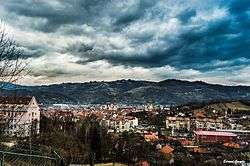Petroșani
| Petroșani | ||
|---|---|---|
| Municipality | ||
 | ||
| ||
 Petroșani Location of Petroșani | ||
| Coordinates: 45°24′44″N 23°22′24″E / 45.41222°N 23.37333°ECoordinates: 45°24′44″N 23°22′24″E / 45.41222°N 23.37333°E | ||
| Country |
| |
| County | Hunedoara County | |
| Status | Municipality | |
| Government | ||
| • Mayor | Tiberiu Iacob Ridzi (Democratic Party) | |
| Area | ||
| • Total | 195.56 km2 (75.51 sq mi) | |
| Population (2011) | ||
| • Total | 34,331 | |
| Time zone | EET (UTC+2) | |
| • Summer (DST) | EEST (UTC+3) | |
| Website | http://www.petrosani.ro/ | |
Petroșani (Romanian pronunciation: [petroˈʃanʲ]; German: Petroschen; Hungarian: Petrozsény) is a city in Hunedoara County, Romania, with a population of 34,331 (2011).
History
"Pietros" means "stony, rocky" in Romanian. The city of Petroșani was founded in the 17th century (around 1640). In 1720, an Austrian cartographer mentions that the entire Jiu Valley was intensly populated and settlements could be seen from one end to the other.
During the 1818 census, Petroșani had 233 inhabitants, while the entire Valley counted 2550. During this time, the main activity of the people was shepherding and no urban settlement had appeared yet.
Around 1840 coal surface mining began in Petroșani, Vulcan and Petrila.
The population experienced massive growth only in the 20th century during the communist regime, as many workers were brought in from other parts of the country.
Geography
Petroșani is located in the Jiu Valley, which is the entrance to the Retezat National Park and provides access to the Vâlcan, Parâng and Retezat mountains. The city administers four villages: Dâlja Mare (Nagydilzsa), Dâlja Mică (Kisdilzsa), Peștera (Zsupinyászuvölgy) and Slătinioara (Szlatinova községrész).
Landmarks
- Sfinții Arhangeli Church ("Holy Archangels Church"), built in the 18th century.
- The "I. G. Duca" school, built in 1935
- The Hungarian school - built in 1873 by Germans and inhabited by a group of 50 Catholic nuns from a monastery near Munich
- The Old Theater, built in 1886
- The Lutheran Church, built between 1892 and 1896
- The Mining Museum, built in 1920
- The actual Sports School building, built in 1919
- The "I. D. Sîrbu" Theater Hall, built in 1905
- The Justice Court building, built in 1910
- The actual Students theater, built in 1922
- The Unitarian Church, built between 1924 and 1928
- The University of Petroșani, built in 1948
- The Jiul Shopping Center, re-opened in December 2007 after renovation, initially built in the early 1980s
Social events
The following social events take place in Petroșani:
- the Dramatic Theater offers a wide variety of performance every week
- the annual international folklore festival
- the Folk Music Festival Cântecul Adâncului... ("Song of the Deep")
- artistic summer camps organized by the Petroșani University
- art, numismatic and caricatures exhibitions
- piano and violin recitals, offered by the Music School
- the Petroșani Days festival, usually organized in autumn
- the annual Underground Valley Graffiti Fest
Demographics
| Historical population | ||
|---|---|---|
| Year | Pop. | ±% |
| 1930 | 15,405 | — |
| 1948 | 14,138 | −8.2% |
| 1956 | 23,052 | +63.0% |
| 1966 | 35,187 | +52.6% |
| 1977 | 40,664 | +15.6% |
| 1992 | 52,390 | +28.8% |
| 2002 | 45,447 | −13.3% |
| 2011 | 34,331 | −24.5% |
| Source: Census data | ||
At the 2011 census, 90.59% of inhabitants were Romanians, 6.54% Hungarians, 1.82% Roma and 0.35% Germans. At the 2002 census, 83.3% were Romanian Orthodox, 7.2% Roman Catholic, 3.7% Reformed, 2.2% Pentecostal, 0.9% belonged to another religion and 0.8% Greek-Catholic.
Gallery
-

Shepherds from Petroşani cca. 1910
-

Petroșani rail station (1867)
-

View of Petroșani cca. 1910
-
.jpg)
-
.jpg)
-
.jpg)
-

-

External links
| Wikimedia Commons has media related to Petroșani. |
- Jiu Valley Portal - the regional portal host of the official Petroșani municipal website

